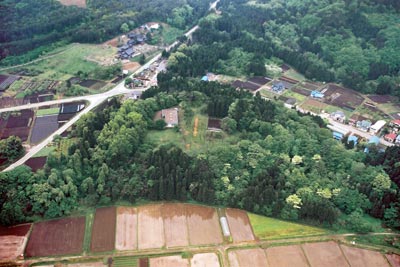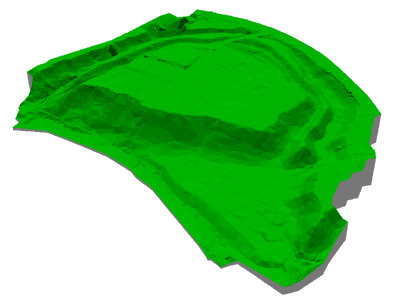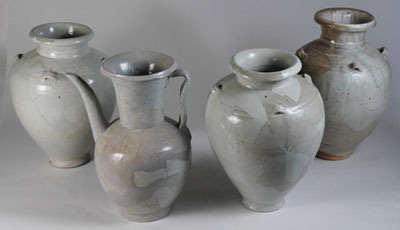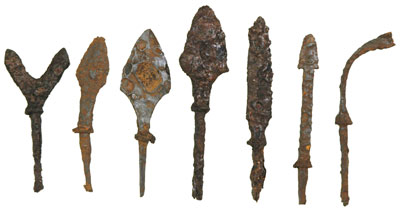Jingamine:
A fortified residence from the end of the Heian period resembling the ōshū Fujiwara family's Yanagi no Gosho remains. Possibly the "Aizu castle" recorded in the diary Gyokuyō.







Aerial view of the site (from the east)
|

3D image of the site |

Large embedded-pillar building
|

Carbonized wooden bowl in situ
|

Recovered Chinese white porcelain
|

Iron arrowheads |
Jingamine Castle Site, Aizubange Town, Fukushima Prefecture
A medieval fortified residence at a strategic point in the Tōhoku region
Jingamine is a fortified site dating from the end of the Heian period, located in the northwestern portion of the Aizu basin of Fukushima Prefecture. This location has been a strategic point for traffic since ancient times, with the former Echigo highway lying to its immediate south, and to its north the Aga river flowing from its point of confluence toward the Niigata plain.
The fortified site sits facing the basin at the eastern edge of a fan-shaped rise, 192 m in elevation and commanding a fine view, its eastern side forming a 20 m precipice. In the dairy Gyokuyō of Kujō Kanezane, the Jō clan of Echigo is said to have held up in the "castle in Aizu" after defeat by Kiso Yoshinaka, at which point Fujiwara no Hidehira dispatched his retainers and wrested the castle from the Jō. One theory holds that Jingamine was this "castle in Aizu." This site and the account of the Jō clan are also recorded in the text Shinpen Aizu fudoshi compiled by the Aizu domain in the Edo period.
A full-scale fortified residence encircled on three sides with a double moat
The horizontal outline of the castle site is roughly pentagonal, with the interior dimensions being 110 m east-west by 175 m north-south. A double moat from 30 to 60 m in width rings the three sides other than the eastern one. From the investigation a large embedded-pillar building was detected in the central portion of the interior, and from this vicinity artifacts such as Chinese white porcelain four-lugged vases and pitchers, Korean celadons, bronze weights and domestically made mirrors, were found in large numbers. Further, to the east of this area porcelain plates, carbonized wooden bowls and balls of rice, plus large quantities of carbonized rice and beans were recovered.
These artifacts are from roughly the twelfth century, and have all been scorched or have been carbonized, and as a wide variety of iron projectile points have been found in large numbers everywhere within the interior, it is possible that the site was victimized by warfare.
According to historical records, this area was the manor Inagawa no shō, part of the estate of the imperial regent's household, and it is thought that the castle site was related in some way to the manor.
Sites that were clearly fortified residences are extremely rare for this period, with the ōshū Fujiwara family's Yanagi no Gosho remains known as an example similar in its topographical location and structure. (Yoshida Hiroyuki)
